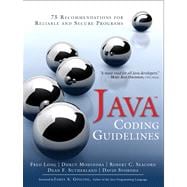“A must-read for all Java developers. . . . Every developer has a responsibility to author code that is free of significant security vulnerabilities. This book provides realistic guidance to help Java developers implement desired functionality with security, reliability, and maintainability goals in mind.”
–Mary Ann Davidson, Chief Security Officer, Oracle Corporation
Organizations worldwide rely on Java code to perform mission-critical tasks, and therefore that code must be reliable, robust, fast, maintainable, and secure. Java™ Coding Guidelines brings together expert guidelines, recommendations, and code examples to help you meet these demands.
Written by the same team that brought you The CERT® Oracle ® Secure Coding Standard for Java™, this guide extends that previous work’s expert security advice to address many additional quality attributes.
You’ll find 75 guidelines, each presented consistently and intuitively. For each guideline, conformance requirements are specified; for most, noncompliant code examples and compliant solutions are also offered. The authors explain when to apply each guideline and provide references to even more detailed information.
Reflecting pioneering research on Java security, Java™ Coding Guidelines offers updated techniques for protecting against both deliberate attacks and other unexpected events. You’ll find best practices for improving code reliability and clarity, and a full chapter exposing common misunderstandings that lead to suboptimal code.
With a Foreword by James A. Gosling, Father of the Java Programming Language








